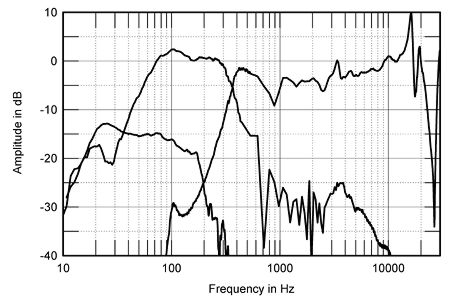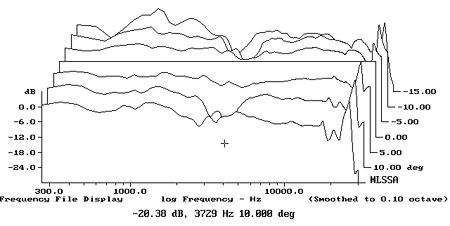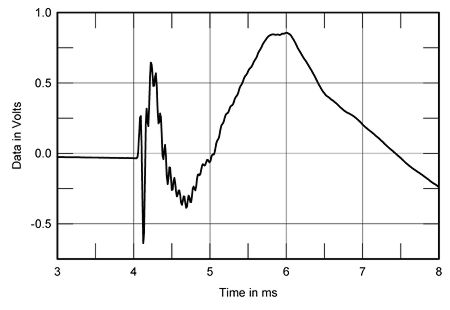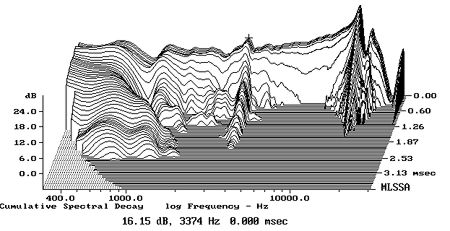| Columns Retired Columns & Blogs |
Triangle Magellan Concerto loudspeaker Measurements
Sidebar 4: Measurements
When I measured the first sample of the Triangle Magellan Concerto, I was disconcerted to find that it drastically lacked treble, with both front and rear tweeters well down in level. The lower trace in fig.1 shows this sample's frequency response, compared with the response of the second speaker of the pair (top trace). All the measurements therefore refer to the second sample; I assumed that the first sample was faulty. The important question is whether this fault had occurred before Paul Messenger performed his review auditioning. Paul told me that the speakers sounded similar to each other, but one of the review samples had been wired with the midrange units and tweeters connected to the "LF" pair of binding posts, and the woofers connected to the "HF" terminals. Before the speakers were shipped to me for measurement, they had been returned to Triangle to have this problem fixed. I can only assume that another error crept in somewhere in this process. (In a conversation with the US importer after the samples had been returned, it was suggested that a component in the tweeter crossover circuit had become short-circuited in shipping.)

Fig.1 Triangle Magellan Concerto, anechoic response on tweeter axis at 50" of first sample (bottom above 3kHz) and second sample (top).
The Triangle was one of the more sensitive speakers I have encountered, its B-weighted sensitivity clocking in at an estimated 93dB(B)/2.83V/m, which is well above average. It might be thought that this would make it suitable for use with low-powered or single-ended amplifiers. However, the speaker's impedance plot (fig.2) reveals it to be a horrible load for the partnering amplifier. The impedance magnitude remains between 2 and 4 ohms over almost the entire audioband, and there is an amplifier-punishing combination of 3.7 ohms and a 44 capacitive phase angle at 78Hz. An amplifier capable of hefty current delivery is going to be a must with this loudspeaker.

Fig.2 Triangle Magellan Concerto, electrical impedance (solid) and phase (dashed). (2 ohms/vertical div.)
There are a couple of wrinkles in the impedance traces, at 170Hz and between 300Hz and 500Hz, that would imply the existence of some kind of cabinet resonance at these frequencies. Investigating the panel's vibrational behavior with a simple accelerometer revealed a mode at 170Hz (fig.3) as well as a couple higher in frequency, but to Triangle's credit these are all very low in level, considering the panels' large size.

Fig.3 Triangle Magellan Concerto, cumulative spectral-decay plot calculated from the output of an accelerometer fastened to the cabinet's side panel level with the lowest woofer (MLS driving voltage to speaker, 7.55V; measurement bandwidth, 2kHz).
From left to right, fig.4 shows the individual responses of the port, the woofers (all three performed identically), and the midrange-tweeter section. Given the fact that the nearfield measurement technique exaggerates the low-frequency output, the absence of any significant peak in this graph implies an overdamped woofer alignment. The port is tuned to a low frequency, 25Hz, which suggests excellent bass extension, but its output is too far down in level to fully support the woofers' output, at least anechoically. In-room, of course, the usual boundary reinforcement will bring up the level of the low bass, giving, as I found in the case of my own auditioning of the Magellan Concerto, a good combination of bass weight and definition. But as PM noted, this is not a speaker that will ever boom in the bass.

Fig.4 Triangle Magellan Concerto, acoustic crossover on tweeter axis at 50", corrected for microphone response, with the nearfield midrange, woofer, and port responses plotted below 350Hz.
The woofers roll off with a steep slope above 300Hz, but there is some upper-midrange output evident in fig.4. The midrange units also roll off below the crossover point with a steep slope, a slight but well-suppressed peak at 100Hz suggesting that this is the tuning frequency of their subenclosure. The response slopes up throughout the treble, with a massive peak evident just below 17kHz, and another evident at the 30kHz limit of this graph. As PM notes, the audibility of this peak will depend on the age, hence high-frequency hearing sensitivity, of the listener. But I was just aware of its existence, as a faint whistle on pink noise, in my own auditioning of the good sample of the Concerto. (I always listen to a speaker in mono as well as stereo, as this is the best way of detecting coloration and balance problems. With the Concerto, of course, I had no choice.)
Fig.5 shows how these individual responses add up on the tweeter axis in the farfield. (This curve is a composite, comprising the farfield response averaged across a 30 degrees horizontal window spliced at 300Hz to the complex sum of the nearfield responses, taking into account the radiating areas, the acoustic phase, and the distance from the nominal farfield point of each diaphragm.) The bass rolls out earlier than might be expected given the speaker's size, but the average balance is flat between the lower midrange and the top audio octave. However, a suckout can be seen in the midrange, above which there is a sharply defined presence-region peak. This latter correlates nicely with PM's comment that the Magellan Concerto's upper mids "were a little forward and projected, which tended to highlight detail somewhat at the expense of the total perspective." The response behind the speaker (not shown) is basically identical to the output of the front-firing tweeter and midrange unit, with the rear drive-units connected in the same polarity (the so-called "bipolar" arrangement).

Fig.5 Triangle Magellan Concerto, anechoic response on tweeter axis at 50", averaged across 30 degree horizontal window and corrected for microphone response, with the complex sum of the nearfield midrange, woofer, and port responses, taking into account acoustic phase and distance from the nominal farfield point, plotted below 300Hz.
The Concerto's lateral dispersion is shown in fig.6. The transition from the cone midrange unit to the horn-loaded tweeter is well managed, as Triangle claims. However, the tweeter is more directional than usual above 5kHz, which will make playing with the toe-in angle a good means of adjusting the speaker's upper-frequency balance. Note the discontinuities below 1kHz in the radiation pattern; these may well be due to interference between the front- and rear-mounted midrange units. In the vertical plane (fig.7), a suckout in the upper crossover region develops above the tweeter axis. However, a similar suckout can be seen at microphone positions more than 5 degrees below the tweeter axis, which is a high 48" from the floor. A high seat will be better than a low seat with this speaker, though this suckout might work against the audibility of the presence-region peak noted earlier.

Fig.6 Triangle Magellan Concerto, lateral response family at 50", normalized to response on tweeter axis, from back to front: differences in response 90 degrees–5 degrees off-axis, reference response, differences in response 5 degrees–90 degrees off-axis.

Fig.7 Triangle Magellan Concerto, vertical response family at 50", normalized to response on tweeter axis, from back to front: differences in response 15 degrees–5 degrees above axis, reference response, differences in response 5 degrees–15 degrees below axis.
Fig.8 is the spatially averaged response of the Magellan Concerto, taken in my listening room. (I used just the good sample, placing it first in the left position, then the right.) The lightweight bass is in evidence, though I had the speaker well away from the room boundaries for this measurement, in the positions where the Revel Ultima Studios work well. The top octave appears only slightly elevated, but this is a little misleading; a neutral speaker would feature a shelved-down response in this region. The Concerto produces too much HF energy in-room, even without the contribution from the rear-facing tweeter, which will be exacerbated by the over-damped bass alignment. But other than that and a small energy excess in the upper midrange, the overall response is impressively flat.

Fig.8 Triangle Magellan Concerto, spatially averaged, 1/3-octave response in JA's listening room (good sample only measured in both L and R positions).
In the time domain, the Magellan's step response (fig.9) indicates that all the drive-units are connected with the same positive acoustic polarity, the step of each blending smoothly into that of the next lower in frequency—but the ringing from the horn-loaded tweeter is very much in evidence. This is graphically shown in fig.10, a cumulative spectral-decay plot calculated from the Triangle's farfield response on the tweeter axis. A big ridge of delayed energy is apparent just below 17kHz, but of more subjective consequence is the similar ridge at 3.4kHz, the region where the ear is most sensitive.

Fig.9 Triangle Magellan Concerto, step response on tweeter axis at 50" (5ms time window, 30kHz bandwidth).

Fig.10 Triangle Magellan Concerto, cumulative spectral-decay plot at 50" (0.15ms risetime).
Some things the Triangle Magellan Concerto does very well—the high sensitivity and dynamic range, the well-controlled treble dispersion, the optimally aligned bass tuning, the overall in-room response flatness. But its impedance will make significant demands for current on the partnering amplifier, and I don't like to see the resonant energy in the presence region and the top octave. Overall, however, the Concerto features some impressively thorough engineering.— John Atkinson
- Log in or register to post comments




































